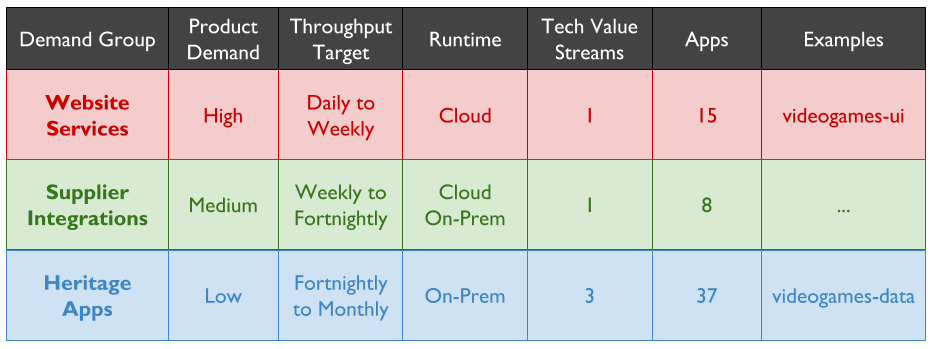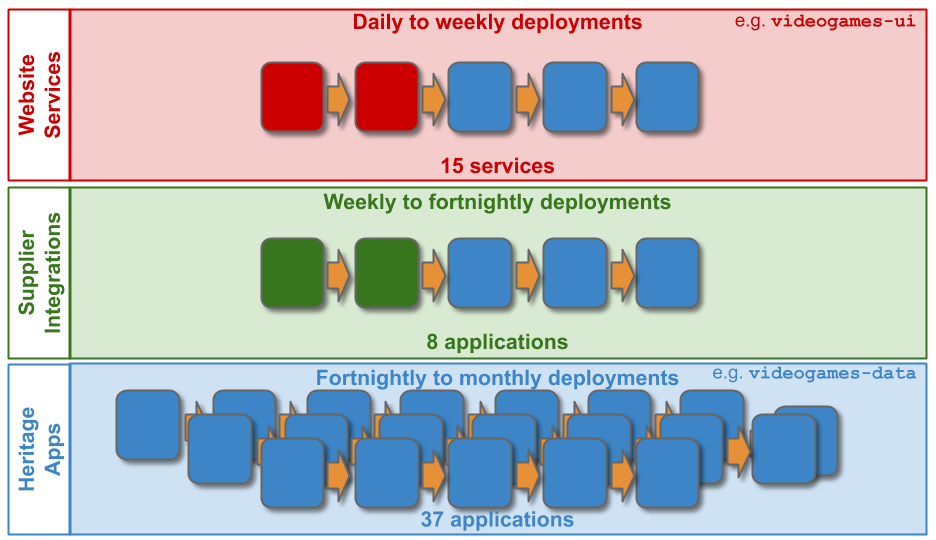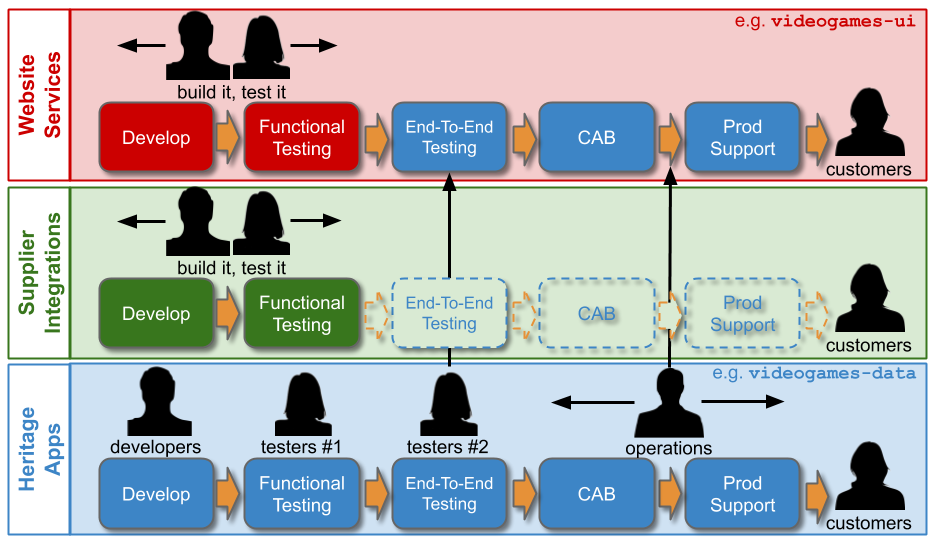What is Multi-Demand IT? How does it provide the means to drive a Continuous Delivery programme with incremental investments, according to product demand?
This is Part 3 of the Strategising for Continuous Delivery series
Introduction
Multi-Demand IT is a transformation strategy that recommends investing in groups of technology value streams, according to their product demand. While Bimodal IT recommends upfront, capital investments based on an architectural division of applications, Multi-Demand favours gradual investments in Continuous Delivery across an IT estate based on product Cost of Delay.
A technology value stream is a sequence of activities that converts product ideas into value-adding changes. A demand group is a set of applications in one or more technology value streams, with a shared throughput target that must be met for Continuous Delivery to be achieved. There may also be individual reliability targets for applications within a group, based on their criticality levels.
Uncover demand groups
An IT department should have at least three demand groups representing high, medium, and low throughput targets. This links to Dr. Nicole Forsgren’s research in The Role of Continuous Delivery in IT and Organizational Performance, and Simon Wardley’s Pioneers, Settlers, and Town Planners model in The Only Structure You’ll Ever Need. Additional demand groups representing very high and very low throughput targets may emerge over time. Talented, motivated people are needed to implement Continuous Delivery within the unique context of each demand group.
Multi-Demand creates a Continuous Delivery investment language. Demand groups make it easier to prioritise which applications are in a state of Discontinuous Delivery, and need urgent improvement. The aim is to incrementally invest until Continuous Delivery is achieved for all applications in a demand group.
Applications will rarely move between demand groups. If market disruption or upstream dependents cause a surge in product demand, a rip and replace migration will likely be required as a higher demand group will have its own practices, processes, and tools. When product demand has been filled for an application, its deployment target is adjusted for a long tail of low investment. The new deployment target will retain the same lead time as before, with a lower interval. This ensures the application remains launchable on demand.
A high or medium demand group should contain a single technology value stream. This means all applications with similar demand undergo the same activities and tasks. This reduces cognitive load for teams, and ensures all applications will benefit from a single flow efficiency gain. A low demand group is more likely to have multiple technology value streams, especially if some of its applications are part of a legacy estate.
Example – MediaTech
Assume MediaTech adopts Multi-Demand for its IT transformation. There is a concerted effort to assess technology value streams, and forecast product demand. As a result, the following demand groups are created:

videogames-ui is in the sole Website Services technology value stream, while videogames-data is in one of the Heritage Applications technology value streams.

Create Multi-Demand policies
A demand group will have a policy set which determines its practices, processes, and tools. Inspired by Cynefin, a policy can be a:
- Policy Fix: single group, such as heightened permissions for teams in a specific group
- Policy Rule: multi-group single implementation, such as mandatory use of a central incident management system for all groups
- Policy Guideline: multi-group multi-implementation, such as mandatory test automation with different techniques in each group
A policy will shape one or more activities and tasks within a technology value stream. Each demand group should have a minimal set of policies, as Little’s Law dictates the higher the throughput target, the fewer activities and tasks must exist. Furthermore, applying the Theory Of Constraints to Continuous Delivery shows throughput in a technology value stream will likely be constrained by the impact of a single policy on a single activity.
At MediaTech, the Multi-Demand lens shows videogames-data is in a state of Continuous Delivery while videogames-ui is in Discontinuous Delivery. This is due to the inheritance of End-To-End Testing, CAB meetings, and central production support policies from Heritage Apps, which has lower product demand and a very different context.

Policy Rules should be treated with caution, as they ignore the context and throughput target of a particular demand group. A Policy Rule can easily incur handoffs and rework that constrain throughput in a high demand group, even if it has existed for lower demand groups for years. This can be resolved by turning a Policy Rule into a Policy Guideline, and re-designing an activity per-demand. For example, End-To-End Testing might be in widespread use for all medium and low demand applications. It will likely need to be replaced with Contract Testing or similar with high demand applications.
This is Part 3 of the Strategising for Continuous Delivery series
- Strategising for Continuous Delivery
- The Bimodal Delusion
- Multi-Demand IT
- Multi-Demand Architecture
- Multi-Demand Operations
Acknowledgements
Thanks to Thierry de Pauw for reviewing this series.